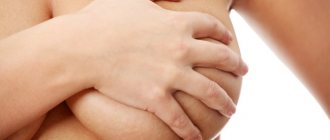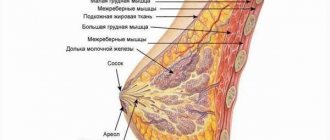Breast pain after sex can be due to physiological reasons, injuries, or due to the formation of processes of pathological origin. If the pain does not disappear, but intensifies, you should consult a doctor.
How long have you had this pain syndrome?
- Several days (26%, 782)
- First day (21%, 634 Votes)
- Several months (13%, 382)
- Week (10%, 309)
- Several weeks (10%, 301)
- About a month (8%, 250)
- Chronic form (7%, 205)
- About a year (6%, 181)
Total voters: 3 045
Loading …
Use search Are you having a problem? Enter “Symptom” or “Name of the disease” into the form, press Enter and you will find out all the treatment for this problem or disease.
Why do my breasts hurt after sex?
According to physiological characteristics, the breast and nipple have many nerve endings, so when they are intensely stimulated during sexual intercourse, the receptors react very strongly.
Pain in the mammary gland can be bothersome when:
- Hormonal surge. During intimacy, endorphins and sex hormones are released, leading to breast swelling and enlargement. The body prepares for pregnancy, but when fertilization does not occur, it responds with a reaction in the form of pain.
- Losing my virginity. Soreness appears due to hormonal changes.
- Traumatic injuries. In a fit of passion, a sexual partner may squeeze the breasts too hard or intensely stimulate the nipples, which leads to soreness.
- Wearing uncomfortable underwear. When having sex in a bra, there is a disturbance in blood circulation and pressure on the mammary glands and nipples increases, because they are enlarged at this time. As a result, after intimacy, pain and discomfort may occur.
- Approaching menstruation. Unpleasant sensations simultaneously appear in the abdominal area, approximately a week before menstruation.
- Formation of diseases – mastitis, oncology.
- Infectious lesions of the mammary glands. A woman is constantly bothered by mastalgia, and after sex there is an increase in its intensity.
- Lymphadenitis of the axillary lymph nodes.
What symptoms accompany breast swelling?
The swelling compresses the nerve roots, which results in discomfort, in the form of a feeling of heaviness and unpleasant distension of the gland, and then pain.
The intensity of pain is directly dependent on the swelling of the breast, but the perception of the severity of pain is very individual. Excess fluid leads to enlargement and deformation of the mammary gland. With inflammatory edema, the temperature of the skin increases and its color changes. With a very pronounced accumulation of fluid in the tissues, redness gives way to cyanosis and even marbled pallor of the skin due to blockage of venous vessels by blood clots.
Our expert in this field:
Sergeev Pyotr Sergeevich
Deputy chief physician for medical work, oncologist, surgeon, Ph.D.
Call the doctor
What to do if you experience chest pain after intercourse
To determine the cause of breast pain, it is better to consult a doctor: a mammologist or gynecologist. He will prescribe a series of examinations to determine the provoking factor and, if necessary, a course of treatment.
In case of traumatic injury, it is forbidden to apply heat to the chest, as this can complicate the situation and increase hemorrhage. It is recommended to immediately seek medical help; until this point, you can apply ice.
If the pain is severe, you can take a painkiller, but if the cause of mastalgia is unknown, it is better not to do this, as this can complicate further diagnosis and provoke the development of complications.
Swimming pool for the treatment of chest pain
Water is 8 times denser than air, thanks to this the body is in a state of weightlessness, reducing the load on joints and bones. Thanks to visiting the pool, the body hardens, blood circulation improves, muscle fibers are strengthened, and metabolic processes are accelerated.
Water has a stimulating and inhibitory effect on the central nervous system, eliminates the feeling of fatigue, soreness, calms and stimulates blood supply to the brain.
Swimming eliminates spasms of muscle fibers, improves lymph outflow, vascular tone, and accelerates regeneration processes. Thanks to this, there is a decrease in the intensity of pain.
What does dull, pulling, pinpoint, aching or cutting pain in the chest indicate?
Breasts hurt during menstruation because hormonal levels change and temporary changes occur in the body. The condition is not always physiological, often it is a symptom of a disease, the beginning of a pathology.
To find out why the pain appears, they consult with a therapist, who refers the patient to specialists after conducting laboratory and instrumental tests.
During menstruation, the outer layer of the uterine lining is shed. This results in slight physiological bleeding. The condition is formed due to the restructuring of hormones so that the body prepares for conception.
Due to temporary changes in hormonal levels, the volume of the mammary glands increases. But this happens insignificantly, so it is visually invisible.
Some women complain of tingling. This is a normal condition if it goes away immediately after your period ends. When discomfort persists, they look for illness.
Causes of dull chest discomfort:
- mechanical damage, injuries that violate integrity;
- angina pectoris, pre-infarction condition;
- gastritis, increased acidity, stomach ulcer (the syndrome spreads to neighboring formations, so abdominal and chest pain is felt);
- pathologies localized in the respiratory tract (tracheitis, bronchitis, pneumonia, emphysema, tuberculosis);
- neurological diseases (pinching, mechanical damage, inflammation of the nerves running from the spine to the periphery);
- diseases of the musculoskeletal system.
Damage to the spine and nerve tissue extending from it is often observed.
The following types of diseases are formed:
- Osteochondrosis. The vertebrae gradually wear out, the volume of intervertebral discs decreases, and nerve tissue is pinched. The pain radiates to the shoulder, shoulder blade, and chest.
- Intercostal neuralgia. Fibers are pinched when posture is bent, scoliosis. Pinching occurs due to displacement of the vertebrae and ribs. The pain is similar to symptoms of cardiovascular disorders. But taking pills for blood vessels and normalizing blood flow will not help.
Causes of pulling sensations:
- complications after surgery on the mammary glands or surrounding areas;
- postpartum condition, for example, when excess milk appears;
- blockage of glands with compaction from breast milk;
- inflammation of the glands, nipples (mastitis formed due to narrow ducts or accumulation of milk);
- benign tumors (fibroadenoma);
- mastopathy – growth without malignant neoplasms;
- breast enlargement during pregnancy.
Factors causing pinpoint, aching painful sensations:
- blockage of blood vessels, capillaries;
- the onset of inflammation;
- mechanical injury;
- wearing uncomfortable underwear;
- small tumors of a benign or malignant nature that gradually begin to grow.
If a cutting feeling develops, a person should be wary. The condition does not occur normally. It does not occur during premenstrual syndrome, ovulation, or menstruation. This is a sign that manifests itself in diseases and injuries. Often formed due to mechanical damage to the gland, skin, nipples.
When is edema malignant?
Due to thrombosis of the lymphatic vessels by tumor cells, a slight pastiness of the skin occurs when there is a tumor node in the glandular tissue of more than 5 cm. At the same time, there are no tumor cells in the skin of the gland itself, fluid retention is mechanical in nature - the presence of an obstacle, and nonspecific edema is not cancerous, secondary .
Metastases in the axillary lymph nodes contribute to the stagnation of lymph in the outer sections - quadrants of the gland, since the mechanical function of the lymph nodes that pump out fluid from the organ is disrupted. Regression of lymph nodes during chemotherapy or as a result of radiation leads to normalization of tissue condition.
When tumor cells do not form a node, but diffusely spread throughout the tissues, permeating the entire organ, then a specific - primary cancerous edema is formed and this form is called infiltrative-edematous breast cancer. With it, the gland is completely enlarged in size, painfully swollen and hyperemic, dense to the touch.
In any situation, stagnation of fluid in the glands is a sign of organ trouble and requires the intervention of a mammologist. Despite the apparent simplicity and small range of diseases that cause the symptom, making a correct diagnosis is not easy. For error-free diagnosis, excellent equipment and extensive clinical experience are required, all of which is abundantly presented at the Medicine 24/7 Clinic. For us to help you, you just need to call +7 (495) 230-00-01
When you need to see a doctor urgently
It is not always necessary to contact a therapist when signs of discomfort appear. More often, the symptom occurs against the background of hormonal changes during PMS, ovulation, pregnancy, lactation, menstruation and will go away on its own over time. If you are concerned about severe pain, for example, during menstruation, use mild painkillers.
You should consult a doctor if the following additional symptoms appear:
- irradiation to neighboring areas (abdomen, back, shoulders, shoulder blades);
- temperature increase;
- clear, white, purulent discharge from the nipples;
- seals inside the glands;
- sharp, cutting pain that cannot be tolerated;
- a sharp deterioration in health, malaise, fainting;
- soreness that does not go away over time.
With any symptom, contact a therapist or gynecologist.
They refer for the following types of examinations:
- general blood and urine analysis - reveal the function of the circulatory and lymphatic systems;
- biochemical test - determination of the amount of transaminases;
- coagulogram - determination of coagulation activity;
- biopsy with histology - normal, benign, malignant cellular composition is detected;
- mammogram;
- chest x-ray;
- study of tumor markers.
If the examinations are inconclusive, MRI is used. It shows the image of organs on the screen layer by layer. It becomes clear where the pathology of blood vessels, nerves, muscles, ligaments, tendons, and bones is formed.
After receiving information and suggesting a diagnosis, the patient is sent to specialists. These include a neurologist, cardiologist, phlebologist, endocrinologist, and oncologist.
Top medications to reduce pain
The definition of pain medication depends on the symptoms and the disease causing the symptom.
There are indications and contraindications; not all medications are well tolerated:
- Antispasmodics. Prescribed for spasms of smooth muscles. They lead to a narrowing of the lumen of the vessel, reducing muscle soreness. They use Spazmalgon, Spazgan. They have few side effects and contraindications and are well tolerated. Not recommended during pregnancy and lactation.
- Non-steroidal anti-inflammatory drugs. These are analgesics that eliminate pain, inflammation, and fever. The effect occurs when the activity of prostaglandins is suppressed. These are the drugs of choice; there is no dependence on them. Activation occurs quickly, within 30 minutes. There are many side effects and contraindications. Not recommended for use for more than 10-14 days. They use Ketanov, Dexalgin, Diclofenac. They are taken in tablets or injections. The second form is preferable for excessively severe pain accompanied by hyperthermia. The injections have less effect on the gastrointestinal tract and act faster.
- Analgesics. Most of them have antipyretic activity, reducing body temperature. Pharmacodynamics occurs due to the suppression of prostaglandin function, influencing the thermoregulation center in the hypothalamus. Paracetamol is often used. It eliminates pain in the head, teeth, and is useful for neuralgia, myalgia, and algodismenorrhea. Side effects and contraindications are minor. Well tolerated by patients. Allowed in the 3rd trimester of pregnancy.
- Opioid analgesics. The function of the central nervous system is suppressed. The pain impulse is not perceived, reflexes are inhibited. They use Promedol, Tramadol. They are used only with a prescription; without it, sale in pharmacies is not available. The tablets have many contraindications for use and negative effects. The effect does not last long, the discomfort completely disappears. Drowsiness and decreased concentration are observed. Substances are used only in emergency situations.
When using pain medications, it is important to understand that they do not treat the underlying cause of your symptoms. Suppression of the pain symptom occurs for a while, then it occurs again.
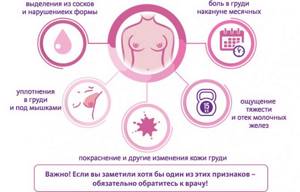
Additionally, drugs are used to treat the underlying cause:
- medicinal components based on hormones (estrogens, progesterones);
- herbal medicines that normalize lactation (Mastodinon);
- antianginal medications that restore the condition of blood vessels, preventing attacks of angina (nitrates, beta-blockers, calcium agonists).
In some cases, medications do not help. For example, for benign and malignant tumors, injuries. Consult with a surgeon about the operation. But for the preparation and subsequent rehabilitation period, an additional list of drugs is prescribed.
Processes in the middle of the cycle
The average length of the menstrual cycle is 28–35 days. It is accompanied by rhythmic changes in hormonal levels, the purpose of which is to prepare a woman for pregnancy. The middle of the cycle occurs on the 14th–15th day. During this period, the mature egg leaves the follicle into the fallopian tube (ovulatory phase). Sometimes deviations from the accepted norm can be observed and menstruation begins on the 17th day or a little later (tachyminorrhea), in which case the moment of ovulation shifts.
From the first day of regulation, the female body begins to intensively produce follicle-stimulating hormone and estrogen. At first, there is a high concentration of estrogen and prolactin in the blood, which contribute to the release of the egg from the ovary. In the second half of the cycle, progesterone predominates in a woman’s body.
The phases of the menstrual cycle greatly affect the condition of the breasts. Under the influence of hormones, the glandular tissue of the milk ducts grows, and the volume of the bust increases.
Pain occurs when the ducts begin to press nearby vessels and nerve endings against the connective tissue. As a result, the outflow of fluid is disrupted, which leads to swelling of the breasts and engorgement of the mammary glands. The nipples become many times more sensitive, because they are “strewn” with precisely those nerves that are compressed for the reasons described above.
If fertilization of the egg does not occur, the glands return to their previous size, discomfort and swelling go away. But around day 19, the remnants of the ovulated egg, known as the corpus luteum, begin to produce progesterone. The steroid hormone is responsible for the development of premenstrual syndrome, so the pain returns before menstruation.
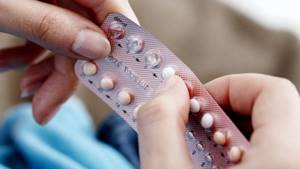
A woman’s hormonal levels are affected by age (puberty, menopause), incorrectly selected OCs, terminated pregnancy, and stress factors. If the cause of breast swelling lies in an imbalance of estrogen and progesterone, changes can be easily detected in a blood test for the level of sex hormones.
Preventive measures
Not every woman wants to wait until things get worse.
Therefore, preventive measures have been developed aimed at preventing diseases:
- Wearing a comfortable bra. It is selected according to size. If it is smaller, the chest is compressed. This is a favorable environment for the development of tumors, injuries, muscle spasms, and lactostasis. Large size leads to sagging and painful sensations.
- Visit to the gynecologist. They come for inspection every year. Laboratory tests are required to understand the functional state of the uterus, ovaries, tubes, vagina, and mammary glands. They are all interconnected.
- Mammogram. It is carried out annually; tumor cells can multiply at any time, growing quickly. The images show normal tissue or early manifestations of compactions. The procedure is contraindicated for women during pregnancy and lactation, as radiation is released during the process.
- Eating quality food. Vitamins, microelements, and minerals that are beneficial for internal organs should be supplied. If there are not enough of them, your health worsens. Laboratory analysis is performed to identify missing substances. According to his data, multivitamins are selected.
- Physical activity. If it is insufficient, muscles weaken and systemic blood flow deteriorates. Nutrients and oxygen reach the organs, including the mammary gland, in a smaller volume.
- Rational use of contraceptives. To ensure adequate use of contraceptive drugs, tests are taken beforehand. They are not available for patients with elevated platelets and coagulation elements. It is prohibited to drink them without the approval of a gynecologist.
- Proper breastfeeding. If the patient does not know how this is done, it is better to clarify this with a feeding specialist. After each feeding, there should be no milk left in the right and left breasts. If the baby does not suck all the colostrum completely, you need to express it. Otherwise, lactostasis will form.
- Hygiene procedures. Keep the body clean to avoid infectious and inflammatory processes. Bacteria often penetrate through the nipples into the glands, especially during pregnancy and lactation.
Preventive measures will not be able to completely protect the patient from the occurrence of sudden pathologies, but they reduce their possibility. They are guided not just once, but throughout life.
If a woman is at risk, she undergoes laboratory and instrumental examinations more often. For example, when a benign tumor forms, the blood is periodically checked for the presence of tumor markers in order to identify the beginning of a malignant process.
Discomfort not related to illness
In some cases, pain in the mammary gland may occur without the development of pathological processes. There are several situations where unpleasant sensations and discomfort do not affect the state of health.
Premenstrual syndrome
The hormonal background of women is subject to changes. In the period before the onset of menstruation, the female breast reacts to a decrease in estrogen levels and an increase in progesterone. In this case, water in the glandular tissue of the breast begins to be retained, and the breast becomes heavier and swells. This phenomenon can be observed in women 20–40 years old.
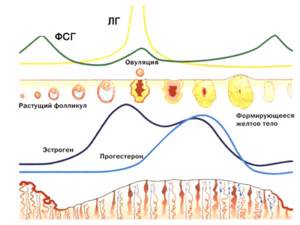
Discomfort also appears when prolactin levels increase. In this case, the chest hurts 5-7 days before the onset of menstruation.
Similar symptoms appear in girls who enter puberty. In this case, an increase in mammary gland tissue leads to painful sensations. After the onset of menstruation, a girl who has become a girl may feel periodic unpleasant symptoms on the sides or in the central part of the chest.
Pregnancy and postpartum condition
When carrying a child, a woman may feel
the appearance of unpleasant sensations in the chest of a stabbing, intermittent nature. Sometimes they accompany her throughout her pregnancy. Often the breasts become swollen from 5 weeks after conception. This process occurs under the influence of changes that the body of the expectant mother undergoes.
The mammary gland may become inflamed after childbirth when lactation is established. In this case, painful sensations appear when the ducts are clogged and lactostasis.
Physical impact
Among the physical factors that cause pain are:
- chest injury due to impact, pressure, increased physical activity;
- incorrectly selected underwear; incorrectly chosen bra, squeezing the breasts during sleep
- chest compression during sleep.
If the negative influence is eliminated, the breasts return to normal. If, after excluding exposure, discomfort still exists, a doctor’s consultation is necessary.
After sexual contact
Women often complain of chest pain after sex. Unpleasant sensations can appear in both the right and left glands. The breast begins to hurt in the nipple area. There are some reasons that cause this phenomenon:
- At the time of sexual intercourse, a hormonal surge occurs, which leads to discomfort in the chest.
- After sex, girls who have lost their virginity may experience unpleasant sensations. In this case, hormones are also responsible for pain.
- When wearing underwear during sex, compression of the mammary glands occurs.
- In some cases, too passionate sex can cause painful sensations. This occurs when the chest is squeezed or pressed during increased activity of the couple.
Hormone therapy
The state of hormonal levels can be affected by taking various medications. Often, if there are problems with conception, medications that normalize hormone levels are prescribed. This therapy is indicated for women suffering from infertility and impaired levels of estrogen and progesterone in the body. Side effects such as breast tenderness may occur as a result of taking medications.
Oral contraceptives, which are used to protect against unwanted pregnancy, have the same properties.
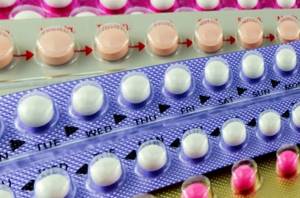
What does sudden pain mean?
The formation of negative feelings during ovulation, menstruation, and pregnancy is a normal physiological process. There's no need to worry about this. The sensations are not sharp, but pulling. They bring a slight loss of strength, but the state of health does not deteriorate significantly.
The appearance of an acute, cutting pain syndrome, radiating to neighboring areas, indicates the formation of the disease. Monitor their condition. If it does not improve within 2-3 days, consult a doctor.
Patients often confuse the conditions, fearing for their lives. For example, a sudden attack of intercostal neuralgia with angina pectoris and myocardial infarction.
They call an ambulance and do different types of tests. It is better to consult a therapist in a timely manner than to miss a life-threatening alarming condition.



